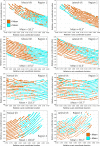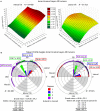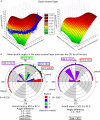Quantitative analysis of the core 2D arrangement and distribution of enamel rods in cross-sections of mandibular mouse incisors
- PMID: 30426488
- PMCID: PMC6326826
- DOI: 10.1111/joa.12912
Quantitative analysis of the core 2D arrangement and distribution of enamel rods in cross-sections of mandibular mouse incisors
Abstract
Considerable descriptive information about the overall organization of mouse mandibular incisor enamel is available but almost nothing is known about the quantitative characteristics of enamel rod arrangement and distribution in these teeth. This has important implications concerning cell movement during the secretory stage because each ameloblast makes one enamel rod. Knowing how many enamel rods are cut open in a cross-section of the enamel layer could provide insights into understanding the dynamics of how groups of ameloblasts form the enamel layer. In this study, cross-sections of fully mineralized enamel were cut on 24 mandibular mouse incisors, polished and etched, and imaged by scanning electron microscopy in backscatter mode. Montaged maps of the entire enamel layer were made at high magnification and the enamel rod profiles in each map were color-coded based upon rod category. Quantitative analyses of each color layer in the maps were then performed using standard routines available in imagej. The data indicated that that there were on average 7233 ± 575 enamel rod profiles per cross-section in mandibular incisors of 7-week-old mice, with 70% located in the inner enamel layer, 27% located in the outer enamel layer, and 3% positioned near the mesial and lateral cementoenamel junctions. All enamel rod profiles showed progressive increases in tilt angles, some very large in magnitude, from the lateral to mesial sides of the enamel layer, whereas only minor variations in tilt angle were found relative to enamel thickness at given locations across the enamel layer. The decussation angle between alternating rows of rod profiles within the inner enamel layer was fairly constant from the lateral to central labial sides of the enamel layer, but it increased dramatically in the mesial region of the enamel layer. The packing density of all rod profiles decreased from lateral to central labial regions of the enamel layer and then in progressing mesially, decreased slightly (inner enamel, mesial tilt), increased slightly (outer enamel layer) or almost doubled in magnitude (inner enamel, lateral tilt). It was concluded that these variations in rod tilt angle and packing densities are adaptations that allow the tooth to maintain a sharp incisal edge and shovel-shape as renewing segments formed by around 7200 ameloblasts are brought onto the occluding surface of the tooth by continuous renewal.
Keywords: enamel formation; enamel rods; quantification; rod decussation; spatial distribution.
© 2018 The Authors. Journal of Anatomy published by John Wiley & Sons Ltd on behalf of Anatomical Society.
Figures










Similar articles
-
Characteristics of the transverse 2D uniserial arrangement of rows of decussating enamel rods in the inner enamel layer of mouse mandibular incisors.J Anat. 2019 Nov;235(5):912-930. doi: 10.1111/joa.13053. Epub 2019 Aug 11. J Anat. 2019. PMID: 31402450 Free PMC article.
-
The spatial distribution of focal stacks within the inner enamel layer of mandibular mouse incisors.J Anat. 2021 Apr;238(4):970-985. doi: 10.1111/joa.13352. Epub 2020 Nov 3. J Anat. 2021. PMID: 33145767 Free PMC article.
-
Distribution and structure of the initial dental enamel formed in incisors of young wild-type and Tabby mice.Eur J Oral Sci. 2009 Dec;117(6):644-54. doi: 10.1111/j.1600-0722.2009.00676.x. Eur J Oral Sci. 2009. PMID: 20121926
-
Maturation stage enamel malformations in Amtn and Klk4 null mice.Matrix Biol. 2016 May-Jul;52-54:219-233. doi: 10.1016/j.matbio.2015.11.007. Epub 2015 Nov 24. Matrix Biol. 2016. PMID: 26620968 Free PMC article. Review.
-
[Mineralization and structure of enamel (a study using scanning electron microscopy and X-ray micro-analysis of the lower incisor of the albino rat)].Arch Ital Anat Embriol. 1989 Apr-Jun;94(2):97-152. Arch Ital Anat Embriol. 1989. PMID: 2694998 Review. Italian.
Cited by
-
Proteomic Analyses Discern the Developmental Inclusion of Albumin in Pig Enamel: A New Model for Human Enamel Hypomineralization.Int J Mol Sci. 2023 Oct 25;24(21):15577. doi: 10.3390/ijms242115577. Int J Mol Sci. 2023. PMID: 37958567 Free PMC article.
-
Characteristics of the transverse 2D uniserial arrangement of rows of decussating enamel rods in the inner enamel layer of mouse mandibular incisors.J Anat. 2019 Nov;235(5):912-930. doi: 10.1111/joa.13053. Epub 2019 Aug 11. J Anat. 2019. PMID: 31402450 Free PMC article.
-
ENAM mutations and digenic inheritance.Mol Genet Genomic Med. 2019 Oct;7(10):e00928. doi: 10.1002/mgg3.928. Epub 2019 Sep 2. Mol Genet Genomic Med. 2019. PMID: 31478359 Free PMC article.
-
The spatial distribution of focal stacks within the inner enamel layer of mandibular mouse incisors.J Anat. 2021 Apr;238(4):970-985. doi: 10.1111/joa.13352. Epub 2020 Nov 3. J Anat. 2021. PMID: 33145767 Free PMC article.
-
ADAM10 Expression by Ameloblasts Is Essential for Proper Enamel Formation.Int J Mol Sci. 2024 Dec 7;25(23):13184. doi: 10.3390/ijms252313184. Int J Mol Sci. 2024. PMID: 39684894 Free PMC article.
References
-
- Boyde A (1969) Electron microscopic observations relating to the nature and development of prism decussation in mammalian dental enamel. Bull Group Int Rech Sci Stomatol 12, 151–207. - PubMed
-
- Boyde A (1989) Enamel In: Handbook of Microscopic Anatomy: Teeth. (eds Oksche A, Vollrath L.), pp. 309–473, Berlin: Springer‐Verlag.

